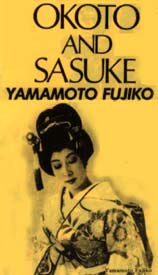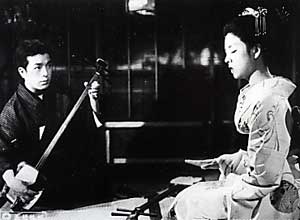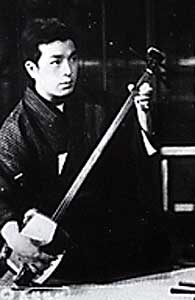In Teinosuke Kinugasa's Okoto to Sasuke or The Koto Player & Her Disciple (Daiei, 1961), a wealthy Osaka apothecary kept the feudal traditions even as the world modernized around him. His second daughter was blind from age nine. As she was regarded as an unlikely candidate for marriage, she received the best training as a koto & shamisen player so that she could live an admirable life as musician & teacher.
 As a beautiful young woman, she does well for herself teaching music to young & grown alike. She takes a disciple, a young man whom she mistreats due to some bitterness within her, & he is masochistically devoted to her. "Each time you hit me," says her disciple under strict shamisen instruction, "I feel closer to you." As a beautiful young woman, she does well for herself teaching music to young & grown alike. She takes a disciple, a young man whom she mistreats due to some bitterness within her, & he is masochistically devoted to her. "Each time you hit me," says her disciple under strict shamisen instruction, "I feel closer to you."
Their relationship may be warped from the beginning, but each gets something they require, & it is in fact deeply romantic. The disciple Sasuke (Kojiro Hongo) strives endlessly to please Okoto, but she is melancholy by nature, & it seems from the start that in each other's company they are likely to be doomed.
There are many scenes of fine koto & shamisen played by the characters & on Ichio Saito's soundtrack. Musically the film is as incredible as its intense acting.
In the first of two scenes of horror, a vengeful jilted suitor sends someone into the blind woman's house by night to poor boiling water on her face as she sleeps. She lives thereafter in terror of Sasuke seeing her disfigurement & would rather remain in bandages. So that he will not see her when they perform together, he keeps his eyes closed & behaves as though blind.
Okoto may have come to realize how much she needs Sasuke, but regards herself as having become monstrous & will never permit him to see her. She believes if he sees her face even once, he will never again be able to think of the beautiful woman he had long adored.
SPOILER ALERT Sasuke lays his plans to blind himself, & the extended sequence in which he thrusts a pin deep into one eye is only sightly less horrific than when he sits back up, composes himself, & holds the long pin in front of his other eye.
Happily he comes to Otoko saying, "I've at last become just like you. Now I needn't close my eyes to imitate you. I won't see the odious scars." Otoko replies, "Am I to feel glad or feel sad?" & then her bitterly sadistic nature melts away into the realization that they are indeed now equals. She exclaims, "Sasuke! I'm a lucky woman. I'm not alone in the world anymore."
They swear devotion to one another & to their music. This happy ending of two people who came together through mutilation has a deep beauty & weirdness to it. In the end Okoto with the scarred half of her face within a half-hood sits listening to a skylark sing & is for the first time in her life hopeful about existence. They become famous throughout Japan & both wrote musical masterpieces. END SPOILER ALERT
 This visually gorgeous film is based on a novella published in 1933 by Junichiro Tanizaki, & perfectly captures the grotesque & romantic tone of the original. It had been earlier filmed by Yasujiro Shimazu as Shinkinsho: Okoto to Sasuke (1935), with Kinuyo Tanaka & Kokichi Takada as Okoto & Sasuke. Kinuyo was a top musician in her day (especially on biwa) & was perfectly cast. This visually gorgeous film is based on a novella published in 1933 by Junichiro Tanizaki, & perfectly captures the grotesque & romantic tone of the original. It had been earlier filmed by Yasujiro Shimazu as Shinkinsho: Okoto to Sasuke (1935), with Kinuyo Tanaka & Kokichi Takada as Okoto & Sasuke. Kinuyo was a top musician in her day (especially on biwa) & was perfectly cast.
The 1935 version is a gloomy film noir & very much the equal of the color remake; indeed it would be difficult to gauge either film better than the other, though inexplicably only the earlier version is ever included on lists of great classics.
It was refilmed again as Spring Koto aka A Portrait of Shunkin (Shunkinsho, 1976) directed by Natsumi Nishikawa & starring Momoe Yamaguchi & Tomokazu Miura. Teinosuke Kinugasa's superb script from the 1961 version was used, but the baby-faced actors were too immature to quite equal the 1935 & 1961 performances.
One other version I would dearly love to see, especially as it was directed by the great Daisuke Ito, is Shunkin monogatari (1954) with Machiko Kyo as the blind koto player & Yoshiaki Hanayagi as her disciple.
copyright © by Paghat the Ratgirl
|

 As a beautiful young woman, she does well for herself teaching music to young & grown alike. She takes a disciple, a young man whom she mistreats due to some bitterness within her, & he is masochistically devoted to her. "Each time you hit me," says her disciple under strict shamisen instruction, "I feel closer to you."
As a beautiful young woman, she does well for herself teaching music to young & grown alike. She takes a disciple, a young man whom she mistreats due to some bitterness within her, & he is masochistically devoted to her. "Each time you hit me," says her disciple under strict shamisen instruction, "I feel closer to you."